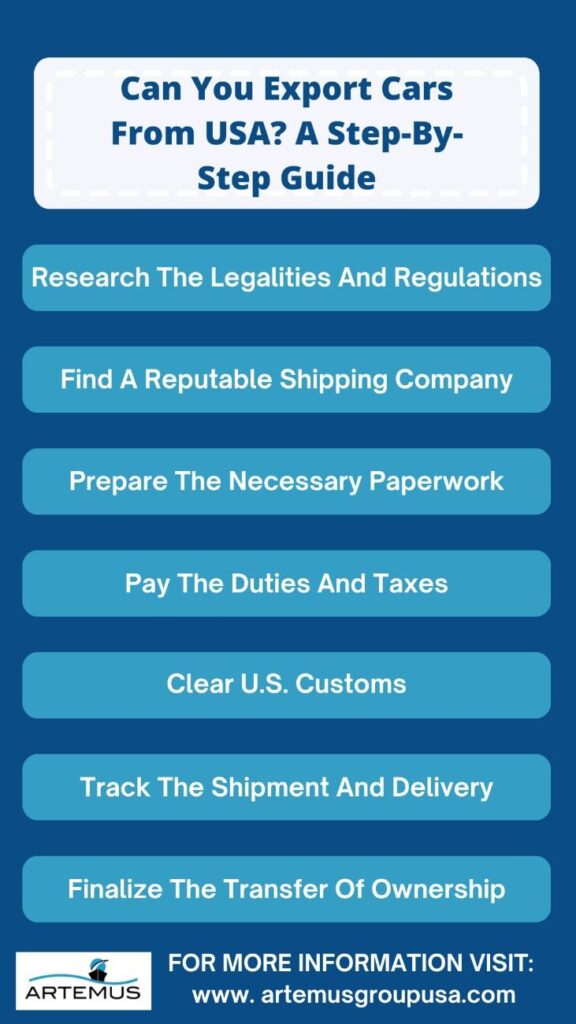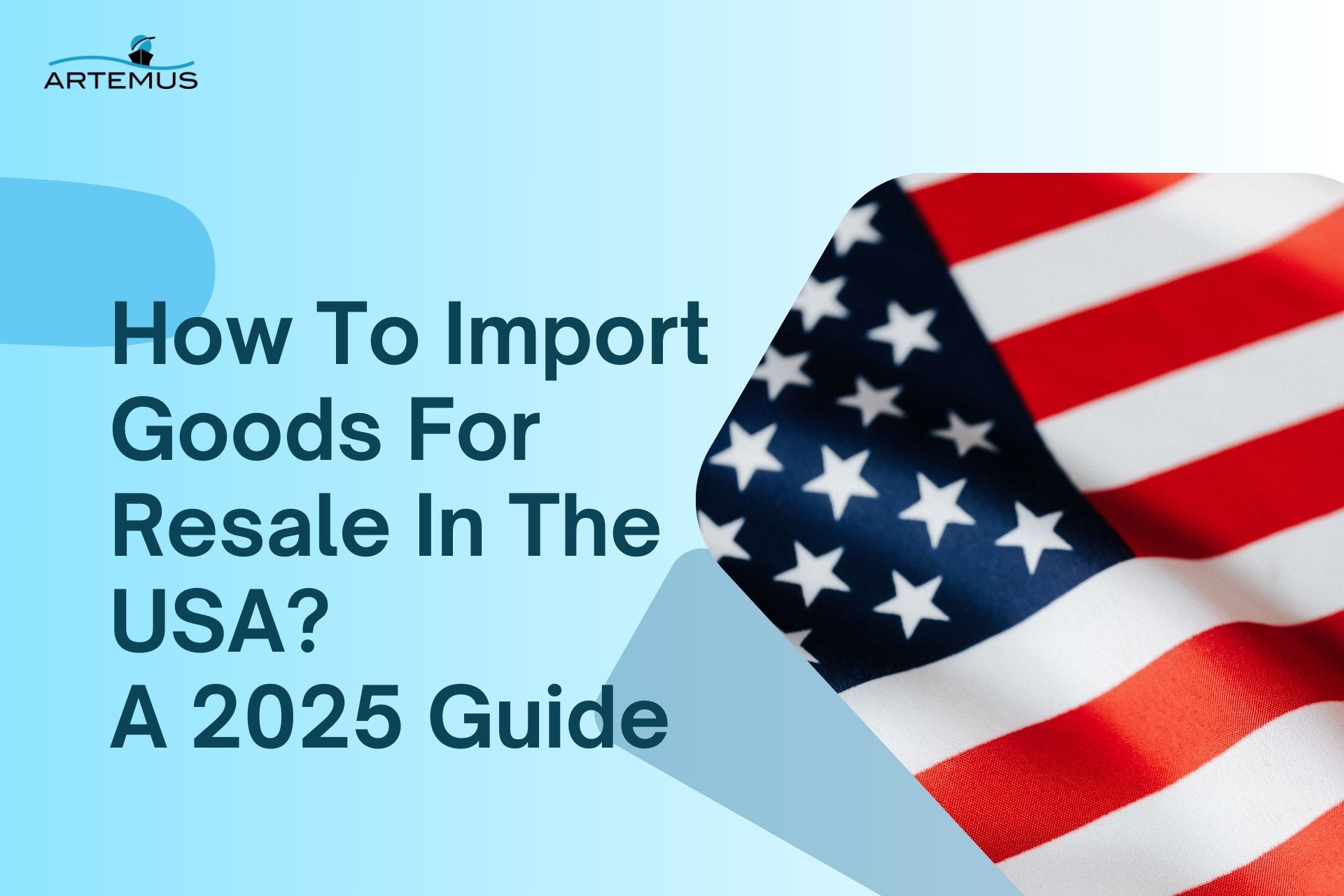
What Is Inbound Logistics & Outbound Logistics? A 2025 Guide
In the dynamic world of supply chain management, understanding the nuances of inbound and outbound logistics is crucial for operational

Exporting cars from the USA involves complying with legal and customs regulations. It requires proper documentation, including title and registration, and ensuring the vehicle meets the destination country’s standards.
The shipping method chosen, such as containerized or RoRo shipping, will depend on the vehicle type and destination. Additionally, customs duties and taxes may apply depending on the receiving country’s regulations.
Artemus offers ISF, AMS, and AES filing software to simplify the export process. This tool helps streamline compliance with U.S. export regulations, making the process more efficient and reducing potential delays.
Table Of Contents

Exporting cars from the USA is a viable option for individuals and businesses looking to ship vehicles overseas. Whether you’re exporting for personal use or business purposes, understanding the process is essential to ensure smooth transportation and compliance with legal requirements.
Here’s a step-by-step guide to help you navigate the process of exporting cars from the USA.
Before exporting a car, it’s crucial to understand the legal and regulatory requirements of both the U.S. and the destination country.
The U.S. Department of Transportation (DOT) and the Environmental Protection Agency (EPA) set regulations that vehicles must meet before they are exported. Make sure the car complies with these standards.
Additionally, every country has different import restrictions, taxes, and duties, so it’s important to research the specific regulations of the destination country.
Choosing the right shipping company is a critical part of the export process. You can opt for two primary methods of shipping a car:
Select a shipping company that specializes in vehicle exports to ensure they handle both logistics and paperwork.
You’ll need to gather the correct documentation to ensure the car is legally exported and cleared by customs.
You will require the title and registration of the vehicle to prove ownership, along with a bill of sale that confirms the transaction.
Additionally, you may need an Export Declaration for U.S. Customs and EPA and DOT compliance forms if applicable, showing that the vehicle meets the environmental and safety standards required by U.S. authorities.
Exporting a car comes with associated costs, such as export fees to the U.S. government and taxes or import duties that the destination country may impose. Be prepared for additional charges related to shipping and clearance.
The amount of taxes and duties will vary based on the vehicle’s value, the destination country, and the shipping method chosen.
Once your paperwork is complete and the car is ready for export, it must clear U.S. Customs. This process involves inspection and approval of all necessary documents to ensure that the vehicle meets the legal requirements for export.
Filing an Export Declaration with U.S. Customs and Border Protection (CBP) is necessary to ensure that the vehicle can leave the country.
After shipping, track the vehicle’s progress using the tracking information provided by the shipping company.
Once the car arrives at the destination port, it will go through customs in the destination country. Once cleared, the car will be delivered to the buyer or final destination.
Upon successful delivery of the vehicle, ensure the car’s ownership is legally transferred to the buyer. The specific steps for this will depend on the laws of the destination country, and additional paperwork may be required to finalize the transfer.
By following the correct steps, you can successfully export a car from the USA, ensuring compliance with all regulations and a smooth shipping process.
Related: What Is AMS In Shipping Industry? A Beginner’s Guide
Exporting a new car from the USA is a straightforward process if you follow the necessary steps and adhere to the relevant regulations. Whether you’re buying a car to use abroad or as part of a business venture, here’s a comprehensive guide to help you export a new car from the USA successfully.
To export a new car, you need proof of ownership. In the case of a brand-new car:
New cars must meet certain regulatory requirements before export:
Choose a shipping method suitable for your car and destination:
Proper documentation is critical for exporting a new car. You’ll need:
While not mandatory, working with a customs broker or freight forwarder simplifies the process. They will:
Present the car and its documentation to US Customs and Border Protection (CBP) at the port of export:
Protect your new car during transit by arranging for marine insurance. Work with a reputable shipping company and consider:
Different countries have unique import rules. Research the destination country’s requirements, including:
Monitor the shipment using tracking services provided by the shipping company. Once the car arrives:
After customs clearance, complete the registration process in the destination country. Ensure:
Before exporting a car from the USA, it’s essential to determine whether the vehicle is eligible for export. Several regulations, safety standards, and environmental requirements must be met for a car to be legally exported.
Here’s how you can find out if a car is eligible to be exported from the USA.
The U.S. Department of Transportation (DOT) sets safety standards for vehicles being exported. To determine if a car is eligible, you need to ensure that it complies with these safety regulations. The car should meet all federal safety standards, including features like airbags, seat belts, and crashworthiness.
To verify compliance, you can check the vehicle’s Vehicle Identification Number (VIN) against DOT’s database or consult the manufacturer to ensure the car is compliant with U.S. regulations.
The Environmental Protection Agency (EPA) enforces standards on vehicle emissions. A car must meet EPA emissions requirements to be exported from the USA. For vehicles manufactured after 1968, the EPA provides a certificate of compliance to confirm that the car adheres to emissions standards.
Check the car’s emissions rating and confirm if it meets the EPA’s standards. If the car is not EPA-compliant, you may need to modify it before exporting.
Before exporting a car, it’s important to ensure that the vehicle doesn’t have any outstanding liens or unpaid debts. A car with a lien cannot be exported unless the lien is cleared.
To check for liens, you can request a title search from the state’s Department of Motor Vehicles (DMV) or use online lien search services.
Every country has specific import regulations, and it’s crucial to ensure that the car complies with the destination country’s standards.
Some countries may require additional modifications to meet local safety or environmental standards, such as left-hand drive vehicles, specific emissions levels, or safety features.
Research the import requirements of the destination country to confirm that the car can be legally imported. You can consult with a customs broker or the embassy of the destination country for more specific information.
For a car to be exported from the U.S., it must meet U.S. Customs and Border Protection (CBP) requirements. This includes submitting the proper export documents, such as the title, bill of sale, and an Export Declaration.
You must also ensure that the car is free from any illegal modifications that could violate export laws.
Consult with a customs broker or export agent to verify that the car is eligible for export according to U.S. CBP standards.
By following these steps, you can verify whether a car is eligible for export from the USA, ensuring a smooth and legal export process.
Related: What Is Import Compliance & Why It Matters?
Exporting a car from the USA requires meeting specific legal regulations and submitting key documentation. Here’s an overview of the essential steps.
Ensure the vehicle meets safety standards set by the Department of Transportation (DOT) and environmental standards by the Environmental Protection Agency (EPA). This includes checking for compliance with emissions and safety features.
Provide the title and registration documents as proof of ownership. The car must be free from liens, and the title should be clear.
The Shipper’s Export Declaration (SED) is required for vehicles valued over $2,500. It provides essential information to U.S. Customs and Border Protection (CBP).
A Bill of Sale proves the transaction and includes vehicle details like the VIN, make, model, and sale price.
For cars made after 1968, EPA Form 3520-1 and DOT Form HS-7 may be required, confirming compliance with emissions and safety standards.
Submit required documents to U.S. Customs for clearance, including title, registration, Bill of Sale, and the SED.
Research the import requirements of the destination country, including any required import permits or emissions certificates.
Consider shipping insurance to cover potential damage to the vehicle during transport. Most shipping companies offer this option.
Ensuring that all documentation is correct and in order will help streamline the export process. Double-check the requirements for both U.S. and destination country regulations to avoid delays.
Related: 5 Types Of ISF Penalty & Fines To Know To Avoid Losses
Proper DMV paperwork is crucial when exporting a vehicle from the USA to ensure it is legally authorized for export. Here’s a breakdown of the required documents and steps.
The vehicle title proves ownership and must be free of liens before export. The registration shows the car’s legal status and should be up-to-date. Both documents are required by the DMV and U.S. Customs for export clearance.
The Notice of Sale or Transfer is filed with the DMV to inform them that the vehicle has been sold or transferred to another party. This document helps protect you from liability after the sale.
You will need to provide identification and proof of ownership (e.g., the title). If the car is not in your name, you must have a legal document showing that you are authorized to export the vehicle.
For vehicles under 10 years old, an odometer disclosure is required to verify the vehicle’s mileage. This is an important step in ensuring the car is accurately represented during the export process.
While not directly DMV paperwork, the Shipper’s Export Declaration (SED) is necessary for U.S. Customs clearance. You must file it with the DMV to ensure that the car is eligible for export.
You must remove the license plates before exporting the car. Depending on your state, you may need to return the plates to the DMV or transfer them to a new vehicle.
Some states may charge fees for processing export paperwork, including title transfer, lien release, and any necessary certifications. Check with your local DMV to confirm the fees involved.
Once the car is sold or transferred for export, you may be required to surrender the vehicle’s registration to the DMV. This helps finalize the export process and officially removes the vehicle from the state’s registry.
By ensuring all necessary DMV paperwork is in order, you can legally export a vehicle from the USA without facing complications with the authorities.
Related: Late ISF Filing: What To Do If Missed The Deadline?
When exporting a car from the USA, various taxes and duties may apply based on the car’s value, destination country, and other factors. Here’s an overview of the taxes and duties involved in the export process.
In general, the USA does not impose taxes on the export of goods, including vehicles. However, there may be export fees that apply when submitting necessary documentation, such as the Shipper’s Export Declaration (SED).
These fees typically cover administrative costs associated with processing the export paperwork.
The most significant cost when exporting a car is often the import duties imposed by the destination country. These duties are typically calculated based on the car’s value, make, model, and year of manufacture. Each country has its own tariff system, which may vary widely.
You should research the specific import duty rate for cars in the destination country to estimate the cost. For example, many countries apply a percentage of the vehicle’s value, which can range from 5% to 30%.
Many countries charge a Value-Added Tax (VAT) on imported vehicles, which is a consumption tax added to the car’s value when it enters the country. VAT rates typically range from 10% to 20%, depending on the country.
It is important to verify whether the destination country applies VAT and to calculate how this will affect the total cost of importing the vehicle.
Some countries impose additional environmental or emissions fees on imported vehicles, especially if they do not meet the destination country’s emission standards. These fees can vary significantly, depending on the age of the car, engine type, or whether the vehicle complies with local emissions standards.
In addition to duties and taxes, many countries charge customs handling fees for processing imported goods. These fees typically cover the costs of inspecting, processing, and clearing the vehicle through customs.
Once the car has cleared customs, the destination country may require registration and licensing fees before the vehicle can be legally driven. These fees may also vary depending on the country, and you should factor them into the overall cost of importing the car.
Depending on the country, you may encounter additional charges like:
By understanding the taxes and duties involved in exporting a car from the USA, you can better plan your budget and ensure there are no unexpected costs during the export and import process.
Related: AMS Fee In Shipping: Overview & 5 Key Considerations
The cost of exporting a car from the USA varies depending on factors like shipping method, destination, and associated fees. Here’s a breakdown of the typical costs involved.
The total cost can range from $1,500 to $8,000, depending on the shipping method, destination, and fees involved.
Related: AMS Filing Penalty Cost: Most Common Pitfalls & Solutions
Exporting a car from the USA involves a complex process, and overlooking key details can lead to costly mistakes. Here are common errors to avoid.
Ensure the car meets both DOT and EPA standards. Failing to confirm this can result in delays or rejection at the border.
Make sure all necessary documents, such as the title, registration, and Shipper’s Export Declaration (SED), are properly completed. Missing or incorrect paperwork can cause customs delays or fines.
Each destination country has specific import rules. Failing to research import duties, taxes, and emission standards could lead to unexpected fees or even the car being denied entry.
Many people skip shipping insurance, but this can be a costly mistake if the vehicle is damaged during transport. Insuring the car provides financial protection against loss or damage.
Remember to remove the license plates before exporting. Leaving them on could complicate the registration process in the destination country and incur extra fees.
Exporting a car involves more than just shipping fees. Customs fees, import taxes, and port handling fees can add up quickly. Make sure to budget for all potential costs to avoid surprises.
Submitting export paperwork too late can lead to delays or missed deadlines. Start the process early to ensure everything is completed on time and avoid rush fees.
By being mindful of these mistakes, you can ensure a smoother, more cost-effective car export process.
Related: Merchandise Processing Fee (MPF): A Complete Guide
Exporting a car can be a complicated task, but with the right approach, you can avoid delays and unexpected costs. Here are some practical tips to ensure a smooth export experience.
Before exporting, research the import regulations of the destination country. This includes understanding import duties, taxes, emissions requirements, and customs procedures to avoid surprises upon arrival.
Ensure that you have all required documents, including the title, registration, Shipper’s Export Declaration (SED), and Bill of Sale. Verify that all documents are accurate and complete to prevent delays at customs.
Select the appropriate shipping method for your vehicle. Roll-on/Roll-off (RoRo) is typically cheaper, while container shipping offers more protection. Consider factors like cost, security, and destination port accessibility when making your choice.
Consider purchasing shipping insurance to protect your vehicle from damage or loss during transit. Insurance is relatively inexpensive compared to the cost of repairs or replacements.
Start the export process well in advance to avoid rushing. Ensure that all paperwork is submitted on time, and allow sufficient time for vehicle inspection and customs clearance. This will help prevent last-minute complications.
If you’re unfamiliar with the export process, hire a customs broker. They can handle paperwork, ensure compliance with regulations, and guide you through the complexities of customs clearance.
Before shipping, remove the license plates and any personal items from the vehicle. This will simplify the customs inspection process and prevent additional fees at the destination.
By following these tips, you can streamline the car export process, reduce costs, and avoid common pitfalls.
Related: ISF Filing Requirements: A Step-By-Step Guide
Artemus is a reliable AES filing software designed to simplify exporting cars from the USA. It ensures that all necessary export documentation, such as Electronic Export Information (EEI), is filed accurately and in compliance with U.S. regulations, minimizing errors and delays.
With an easy-to-use interface, Artemus guides users through the filing process, offering real-time tracking and updates on shipments. Its automation saves time, ensuring that all documents are submitted promptly and correctly.
For exporters seeking a seamless and compliant way to handle car exports, Artemus provides a streamlined solution, making the process more efficient and hassle-free.
Yes, you can export your car from the US to India, but it must meet Indian vehicle regulations, including compliance with environmental and safety standards.
It is not illegal to export new cars from the US, but they must comply with export laws and regulations. Some cars may need to be modified to meet the destination country’s standards.
Yes, American cars are exported to various countries around the world, including Canada, China, Mexico, and the Middle East.
Yes, it is possible to import a car from the USA to another country, but the car must meet the specific regulations and standards of the importing country, including emissions and safety requirements.
Yes, you can buy a car in the USA and bring it to India, but the vehicle must meet Indian import regulations, including safety, emission standards, and modifications.
The cost of importing a car from the USA to India can range from ₹2-5 lakhs (or more) depending on the car’s value, shipping costs, customs duties, and modifications required to meet Indian standards.
Unsold new cars in the USA are often sold at discounted prices, exported to other countries, or sent to auctions. Some may be reconditioned and sold as used cars.
In the USA, cars that are 25 years or older can generally be imported without having to meet modern safety and emission standards, as they are considered classics.
Cars that do not meet US safety and environmental regulations, including vehicles without airbags, or cars that are not compliant with emission standards, cannot be imported into the US.
Canada is the biggest buyer of US-made cars, followed by Mexico and China.
Indian cars are primarily exported to Africa, the Middle East, Latin America, and Southeast Asia, as well as a few countries in Europe.
Germany is the biggest exporter of cars, with manufacturers like Volkswagen, BMW, and Mercedes-Benz leading global exports.

Choosing a reliable shipping method and experienced exporters is key to avoiding delays. Shipping by sea, air, or land will depend on factors like cost and speed, so it’s important to assess the best option for your needs.
Exporting cars from the USA is possible with the right preparation and knowledge of regulations. It’s essential to understand the legal requirements and documentation needed for both the U.S. and the destination country to ensure a smooth process.
In summary, exporting cars from the USA can be straightforward with proper planning and understanding of legal requirements, making it a viable option for international transactions.
Related: Which Party Issues The Export Declaration Document?

In the dynamic world of supply chain management, understanding the nuances of inbound and outbound logistics is crucial for operational

In today’s interconnected world, businesses rely heavily on global trade to expand their markets, access new resources, and drive growth.

Importing goods for resale in the USA presents a lucrative business opportunity, but navigating the complexities of U.S. customs regulations,
Get In Touch
Artemus’ Software Solutions for ISF, AMS, Japan AFR, eManifest Canada, & Panama B2B filings.